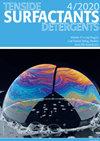Effect of glauconite and SLS surfactant on phosphate and calcite rheology
IF 1.2
4区 工程技术
Q4 CHEMISTRY, APPLIED
引用次数: 0
Abstract
The rheological properties of the flotation slurry are one of the most important factors affecting the separation by this process. The presence of clay in the flotation process causes many problems due to its effect on the slurry rheology. In this study, the effect of glauconitic clay on the rheological behaviour of semi-salt type minerals (phosphate and calcite) in the presence/absence of anionic surfactant (sodium lauryl sulfate, SLS) as flotation reagent was investigated as a preliminary step towards understanding their behaviour during flotation. The results showed that the flow behaviour of each mineral, either phosphate or calcite was Newtonian. When glauconite was added in the absence of surfactant, the behaviour shifted to that of Bingham fluids with yield stress for both slurries. When glauconite was added to phosphate slurry in the presence of the surfactant, the behavior was strictly Newtonian, with a slight increase in viscosity with increasing glauconite content. The addition of SLS to calcite slurries shifted the behaviour from Newtonian behavior to shear thickening, with an increase in yield stress and viscosity with addition of glauconite reaching a maximum value at 10 % addition and then decreasing with further addition of glauconite.海绿石和SLS表面活性剂对磷酸盐和方解石流变性能的影响
浮选浆的流变性是影响该工艺分离效果的重要因素之一。在浮选过程中,粘土的存在会影响矿浆的流变性,从而引起许多问题。在本研究中,研究了在阴离子表面活性剂(月桂基硫酸钠,SLS)存在/不存在的情况下,海绿石粘土对半盐型矿物(磷酸盐和方解石)流变行为的影响,作为了解其浮选行为的初步步骤。结果表明,无论是磷酸盐还是方解石,每种矿物的流动行为都是牛顿的。当海绿石在没有表面活性剂的情况下加入时,两种浆料的行为都转变为具有屈服应力的宾厄姆流体的行为。在表面活性剂存在的情况下,将海绿石添加到磷酸盐浆中,其行为符合严格的牛顿定律,粘度随海绿石含量的增加而略有增加。在方解石浆中加入SLS后,方解石浆的屈服应力和粘度随海绿石添加量的增加而增加,在海绿石添加量达到10%时达到最大值,然后随着海绿石添加量的增加而降低。
本文章由计算机程序翻译,如有差异,请以英文原文为准。
求助全文
约1分钟内获得全文
求助全文
来源期刊

Tenside Surfactants Detergents
工程技术-工程:化工
CiteScore
1.90
自引率
10.00%
发文量
57
审稿时长
3.8 months
期刊介绍:
Tenside Surfactants Detergents offers the most recent results of research and development in all fields of surfactant chemistry, such as: synthesis, analysis, physicochemical properties, new types of surfactants, progress in production processes, application-related problems and environmental behavior. Since 1964 Tenside Surfactants Detergents offers strictly peer-reviewed, high-quality articles by renowned specialists around the world.
 求助内容:
求助内容: 应助结果提醒方式:
应助结果提醒方式:


